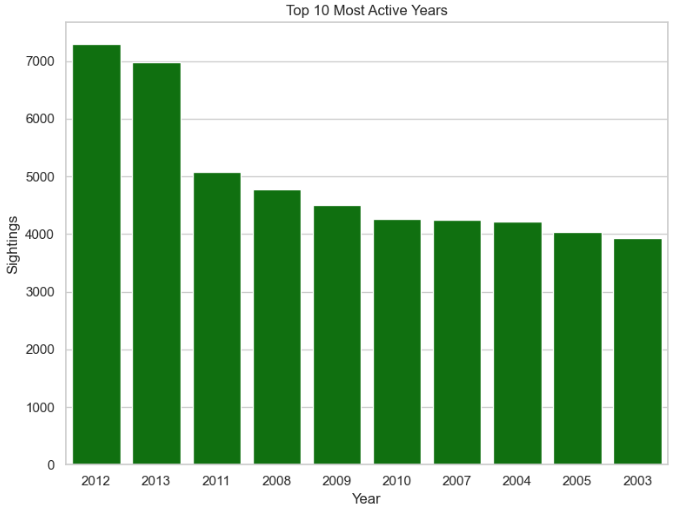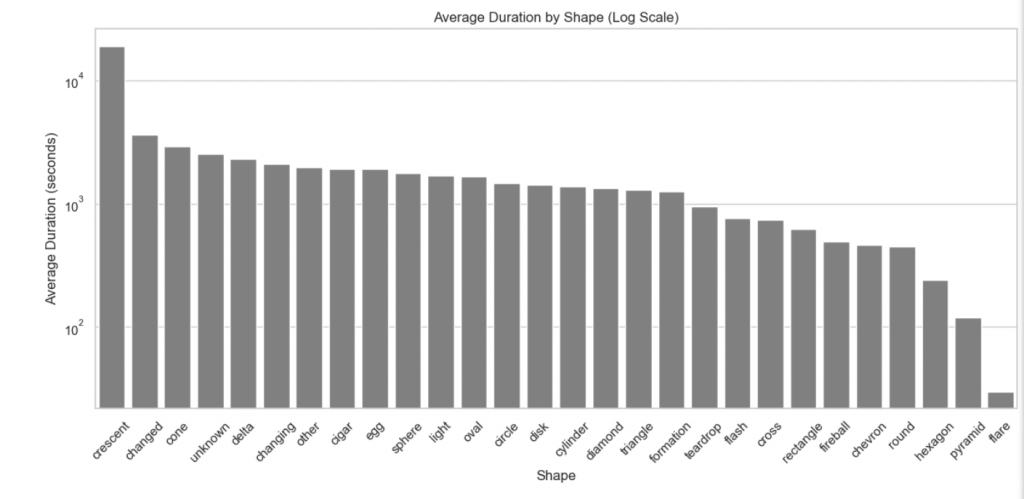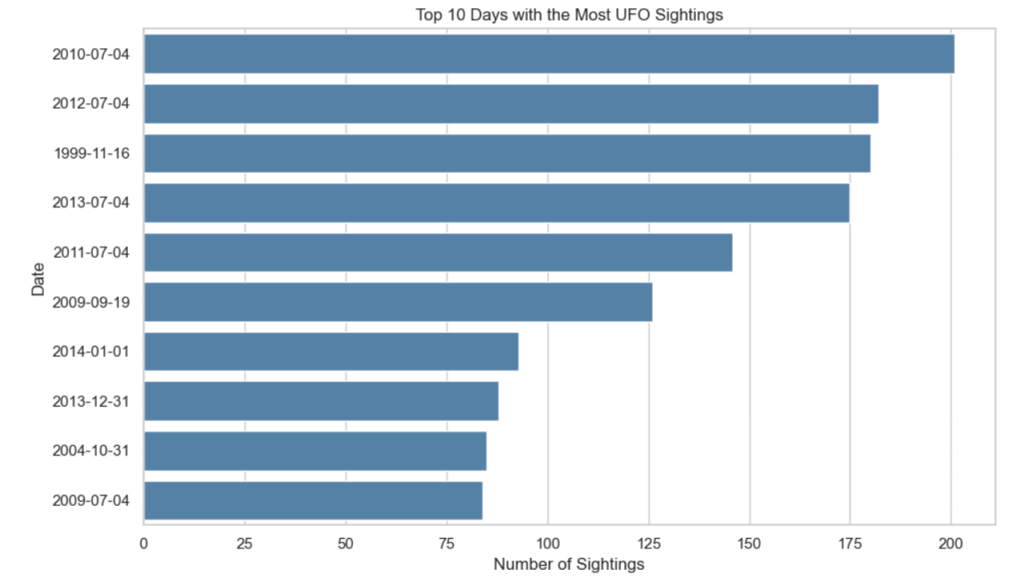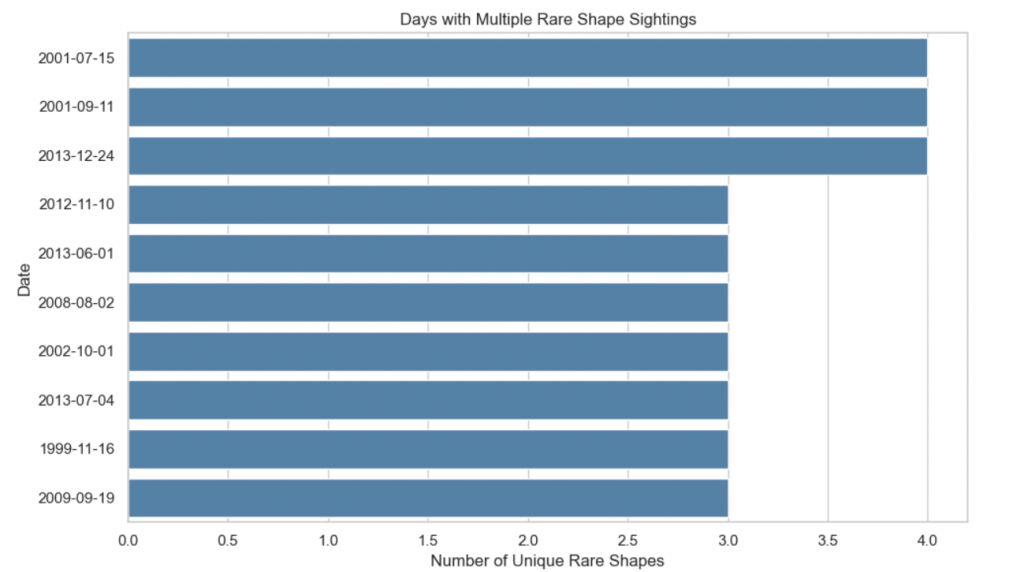For several decades unidentified flying objects (UFOs) have fascinated human minds by creating a complex mixture of scientific elements with mystery and beliefs about them. A significant amount of documented reports shared by everyday people from around the world exists despite popular media coverage of UFO videos. We explored patterns together with cultural correlations and unexpected findings by studying one of the world’s biggest shared databases regarding UFO sightings. Through six chapters this study critically analyzes and uncovers relevant information about the phenomenon across points of time, locations, forms and length and human emotional involvement to provide clear evidence about the distribution and meaning of sightings as they link to our own nature. Whether you’re a skeptic, a believer, or just data-curious, this analysis brings a fresh, analytical lens to one of humanity’s most persistent questions: What exactly are we seeing up there?
The Phenomenon in Time
How Culture, Technology, and Human Habit Shape When We See the Unknown
The historical records of UFO observations reveal more about human behavior than the supposed extraterrestrial sightings because they reflect societal changes. Throughout most of the twentieth century UFO sightings occurred seldom and met little public reception because news spread limited by ancient media systems and traditional attitudes towards unexplained phenomena and reporting methods were scarce. But then, something shifted.


Around 1994, the curve rises dramatically. Multimedia cultural transformations caused the sudden rise in alien encounter reports during the year 1994. The surge of extraterrestrial media content including The X-Files and Independence Day combined with documentaries shown in late-night television broadcasts led to widespread interest and media exposure of the topic. Digital camcorder technology combined with home internet made it possible for anyone to easily produce videos of their sightings and use public platforms including NUFORC and MUFON for reporting. The number of reports reached its highest point in 2012 when Mayan “end of the world” predictions became worldwide news thus increasing sky awareness and doomsday interest.
Then came the drop.
After 2012, sightings plummeted. Was it disillusionment? Better identification of drones and satellites? The shift to social media over formal databases? Probably all three. The dataset closure at 2014 creates an opportunity for sightings to have dropped because of reporting gaps instead of actual disappearances in the night sky.
Zooming into the seasonal cycle, we find an even more familiar rhythm.

March starts sight reports low yet June brings higher numbers which rise dramatically in July before decreasing into winter until February ends. The higher number of visible stars during summer nights matches the increased outdoor activities of human beings.
That same rhythm plays out daily.

The high number of UFO reports occurs at 5:00 PM before reaching its maximum at 9:00 PM and decreasing until it becomes minimal at 8:00 AM daily. This pattern matches the times people spend outdoors and gazing at the sky.
Even day-of-week matters.

The weekend days of Saturday and Sunday rank as the leading times for reported UFO sightings. People spend most of their weekend activities socializing and camping while staying out late and intending to relax under open sky conditions.
But here’s where it gets really human.
When we looked at the day of the month, a peculiar pattern emerged.

Eye-opening patterns occurred exclusively on dates that ended in a 5 like the 5th, 10th, 15th, 20th and further multiplications. Analysis indicates that extraterrestrial beings do not show a preference for specific dates which have whole numbers or result from multiplication by a number five. Digit preference also known as date heaping represents a psychological process through which people tend to round their responses. People who do not recall the precise date usually simplify their response by rounding up. The incident took place during the proximity of the fifteenth day. The minute discrepancies in the UFO reports indicate exactly how much of the UFO narrative results from external contact and internal human memory processes along with social customs and psychological patterns.
Where It Happens — Geography of the Unknown
People view the night sky as their shared artistic workspace while UFO sightings function like spontaneous paint marks which distribute irregularly but expose the characteristics of the individuals who create them. The most clear manifestation of this phenomenon emerges through spatial distribution of reported observations.

American citizens file more than 81% of all UFO reports throughout the world. The extensive number of UFO reports emerging from the United States is not the result of random cosmic events. The occurrence stems from four core elements which involve cultural mythology together with media amplification and social openness and tools for self-expression.
Throughout the 74 post-Roswell incident years the United States has developed a pervasive cultural influence centered on the idea of alien beings. Americans have developed a habit of seeing strange sky lights as meaningful messages since the era of Cold War paranoia merged with the alien-focused film era featuring E.T. and Close Encounters of the Third Kind and Men in Black. National consciousness includes the UFO phenomenon as one of its central components.
Belief by itself cannot create data because infrastructure remains the fundamental factor.
The wide rural areas across the United States along with minimal light pollution make an ideal space to observe stars and study the skies. Americans maintain a free speech policy while utilizing citizen reporting agencies NUFORC and MUFON to make their space observations.

Other countries show faint traces: Canada (4.5%) and the U.K. (2.9%) follow far behind. Despite sharing language, media, and some UFO folklore, their lower population sizes and more conservative reporting environments likely explain the smaller numbers.
Zooming in within the U.S. reveals more variation.

Reports from California outnumber all other states by a staggering margin when reaching 8,000 cases while Washington remains distant in second position with 4,000 reports. California serves as perfect ground for non-conventional ideas because of its large population combined with clear weather conditions along with its expansive rural areas and coastal views and its liberal-minded counterculture attitude.
This chapter reminds us that UFO sightings don’t just depend on what’s in the sky—they rely on who’s willing and able to look up, interpret it, and tell the world.
What People See — Shapes of Mystery
When people see something strange in the sky, they reach for familiar words to explain the unfamiliar. And in the vast catalog of UFO reports, one shape appears again and again—“light.”

Out of all recognized geometric shapes such as disks or triangles the word “light” stands as the most dominant descriptor. This descriptive term remains vast, technical-free, straightforward and instantly comprehensible which works best during nighttime when details become unclear. Numerous items such as stars and drones and meteors and unidentified objects qualify as lights. People observe this particular phenomenon since it represents their initial observable experience thus creating the basis for their verbal explanations.
Yet, something unusual began happening around 2012.

Reports of UFOs described through the term “fireballs” reached exceptionally high numbers in that year due to their increased popularity surpassing traditional descriptions such as “circle” and “sphere” and ranking after “light.” The regular occurrence of fireballs started a widespread phenomenon.
Why?
One explanation is celestial. During the early 2010s the Earth observed increased meteor activity while worldwide news outlets carried reports about the 2013 Chelyabinsk meteor explosion—a bright fireball that caught global attention with its flight over Russia. Public awareness expanded because people now possessed a visual word bank to describe dynamic bright objects in the sky.
There’s also a technological factor. Smartphones equipped with cameras during and after 2010 created the perfect condition for users to record instantaneous moments of brightness. The combination of easily captured fireball videos on YouTube alongside sharing on Reddit and Facebook spawned a continuous feedback process which leads to increased fireball video production as well as reporting by the public. Individuals started applying the same term to various bright sky phenomena during day or night regardless of whether these sights were meteoric in origin.
But what about the rarest shapes?

Among the rarest patterns observed during sightings stand crescent, hexagon, pyramid, flare, cross shapes together with the confusing “changed” classification.
The witnesses showed enough accuracy in their descriptions to demonstrate they had not observed a vague light blur. Objects that appear as hexagons or pyramids suggest both defined structure and elongated observation or proximate interaction with UFOs. These symbolic shapes such as crescent and pyramid encourage people to draw similarities between their eyewitness experiences and mythological depictions, ET speculation, and science fiction fantasies.
Witnesses use the terms “changed” and “flare” as they try to comprehend events that transform or shine too brightly for easy description. The reported shapes could show certain behaviors or even human-made technological characteristics which our current knowledge fails to explain.
So what do these shapes tell us?
They tell us that what we see is filtered through what we know—and what we expect to see. As technologies, trends, and media evolve, so too do the words we reach for when the sky does something strange. UFO shape reports are not just data points—they’re a mirror of perception, shaped by our tools, our culture, and our endless curiosity.
How Long It Lasts — The Duration Dimension
If shapes describe what people think they saw, then duration tells us how long they had to figure it out. And when it comes to UFO sightings, most of these strange encounters don’t last long.

Most unexplained phenomenon reports collect within a 1 to 10,000 second time range and the highest occurrence of such sightings reaches 100 seconds. The duration provides enough time to recognize and respond but remains shorter than the amount needed for complete comprehension. The duration of reported sightings does not seem to vary based on what time of day the observation occurs. Time spans demonstrate identical patterns during all hours of the day from morning through midnight.
But on the fringes of the data, some stories stretch time.
Rare sighting events extend across multiple days to the extent of reaching two or three weeks. The extended observation periods probably do not represent continuous contact because they fall into three possible categories.
Multiple observations from one spot are considered as a single event.
Planets and stars which move slowly through the sky may be mistaken for new objects.
The same natural occurrences that lead to mistaken identifications tend to happen again under comparable situations.
Some prolonged UFO sightings have dates that demand serious attention. A Glendale Arizona UFO report on March 12 1997 occurred exactly one day before the well-known Phoenix Lights mass sighting which became a historic UFO event. Two types of long-duration UFO sightings occurred during Australia Day celebrations with their accompanying fireworks displays or during the peak visibility period of Comet ISON in 2013. The potential correlations between these events remain uncertain between pure chance and hidden evidence that conceals itself within public view.
There’s more.
When we examine the shapes associated with the longest average durations, a fascinating pattern emerges.

The three most uncommon shapes which include pyramid and hexagon and flare match exactly the specific forms we identified in Chapter 3. Our previous hypothesis receives backing because people who observe distinctive geometric objects tend to spend longer periods of observation. The observed phenomena persist longer than momentary flashes because observers spend additional time studying them.
The detailed observation period increases the probability that the observed phenomenon was truly extraordinary. The observation period either enables more embellishment or allows for more error. The data remains intriguing because of its unclear nature.
So how long do UFOs last?
For most people, just enough time to wonder.
For a few, long enough to remember forever.
Additional Significant Dates
Across the UFO dataset, a compelling pattern emerges when we look at the specific dates with the highest number of sightings—many of them coincide with culturally significant, emotionally charged, or astronomically meaningful days. This alignment suggests that human context, not just celestial activity, plays a critical role in when people look up—and what they believe they see.

The U.S. Independence Day on July 4th emerges as the most prominent date for UFO sightings since it appears five times within the top ten most active days (2010, 2012, 2013, 2011, 2009). The night becomes illuminated with fireworks while millions of people watch the sky in complete wonder. Actual UFO sightings and misidentifications become more likely during times when bright lights combine with celebratory moods and large numbers of people watching the sky. New Year’s Eve on December 31st and New Year’s Day on January 1st emerge as significant dates because they combine worldwide fireworks displays with night celebrations and end-of-year excitement which leads to increased sky activity. The periods when people experience increased emotional and visual stimulation lead directly to more reported UFO sightings.
The cultural significance of October 31st as Halloween creates a thinning effect between reality and fantasy since people become more open to paranormal experiences. During this night people become more receptive to paranormal experiences because the environment encourages imaginative thinking. The date of November 16, 1999 happened during the Leonid meteor shower which was one of the most spectacular celestial events of the late 20th century thus increasing the likelihood of mistaken or wondrous identifications.

Additional meaningful patterns become visible by studying days with maximum reports of unusual UFO forms. The date September 11, 2001 stands out because it occurred during the 9/11 attacks which created a time of national emergency and increased vigilance across the country. The increase in unusual reports might have resulted from people watching the skies more because they were either fearful or curious or confused by events. The emotional intensity of Christmas Eve on December 24, 2013 created outdoor celebration conditions that led to extraordinary sightings. On July 4, 2013 the combination of emotional celebration and aerial displays created conditions for reporting unusual imaginative UFO sightings.
Research findings support the main hypothesis which states that UFO sightings represent both atmospheric phenomena and psychological states of human beings. Our understanding of the unknown directly correlates with the cultural and emotional patterns of our communal calendar which can be activated by fireworks, fear or fascination or festivities.
What People Say — Stories from the Ground
Behind every UFO sighting is a voice—someone trying to put the unexplainable into words. While the lights may fade from the sky, their echoes live on in thousands of written reports, each one a fragment of a larger, deeply human narrative.

The language appears functional when you look at it initially. People typically use “Sky,” “light,” “object,” “bright,” “craft” as their main words when describing their sightings. The reported sightings consist mainly of visual elements including orange spheres and red flashes together with white beams that cut through darkness. Directional terms such as « north » and « east » and « horizon » together with movement words including « hovering » and « moving slowly » create quiet images of vehicles traveling through open airspace. Thousands of entries use this shared vocabulary which indicates a standard set of terms that the public uses to describe the unknown.

The recurring phrases “bright light” and “white object” together with “red lights” and “shaped craft” provide standard ways for people to describe size and color and movement. Many reports contain the phrase “NUFORC note” which indicates investigators use standard templates during reporting procedures.
But words only go so far. To understand how people feel about what they saw, we turn to sentiment analysis.

The results are surprisingly level-headed. The majority of reports present information through standard language which documents facts without dramatic expressions or emotional intensity. The majority of reports show positive sentiment through fascination and awe and excitement while negative emotional reactions remain scarce. The way people distribute their reports indicates a fundamental truth because most individuals show no fear about their experiences. They’re curious. People’s curiosity about such encounters might signal their genuine nature.

Time of day reveals subtle shifts in tone. During the early morning period between 4 AM and 7 AM the tone of the text reaches its highest positive point. The emotional engagement of people reaches its lowest point during the middle of the day when they become neutral. During the evening to midnight period which serves as the prime sighting time people experience a balanced reaction while admiring the stars. The negative emotional responses stay steady throughout the day because the experience itself causes fear and anxiety rather than the time of day.
And what about the “A” word?
Estimated 10301 sightings (12.94%) mention aliens or extraterrestrial beings.
A total of 12.94% within the complete dataset contains reports that describe aliens together with extraterrestrials and abductions and beings and similar terms. The reported occurrence rate of 12.94% appears small yet it represents a substantial portion of the data. The reported objects are more than atmospheric lights. Many people experience these sightings as part of their wider story about interacting with something beyond normal explanation.
When inspecting this percentage across some significant dates one date in particular stands out: January 1, 2000. Nearly 18% of sightings near this day reference alien themes, far above the average. The cause? Likely the turn of the millennium—Y2K, a time thick with apocalyptic anxiety and speculation about otherworldly intervention.

The sentiment toward alien mentions shows different patterns depending on which occasion people mention them. The festive atmosphere of Independence Day (July 4th) and New Year’s Day leads to positive sentiments about aliens which may indicate an open and celebratory mindset. But September 11, 2001, tells a different story. The number of sightings during this period shows the strongest negative sentiment because it matches with the national trauma and psychological distress experienced by the country. The Christmas Eve and Phoenix Lights (March 1997) occurrences demonstrate balanced to positive reactions which express wonder alongside curiosity instead of fear.
Together, these voices—word by word, sentence by sentence—form the emotional backbone of the UFO phenomenon. They reveal not just what people saw, but how they processed it: through surprise, wonder, calmness, and sometimes, belief. Far from sensational, most accounts are carefully worded, emotionally balanced, and strikingly human.
Conclusion — What the Skies Say About Us
A century of UFO sightings demonstrates that the phenomenon reflects human psychology as much as it does possible extraterrestrial existence. The collected data shows both celestial patterns along with human behavioral patterns and cultural and memory patterns and imaginative patterns.
This investigation demonstrates that UFO sightings mirror how people react to mysteries through their increased sightings in the mid-90s and their emotional responses to specific dates and their choice of words when reporting sightings. The majority of UFO reports occur during summer seasons and weekend evenings because humans spend their time outdoors observing the sky. People experience bizarre visual patterns along with extended periods and sensational descriptions when major holidays or media events or astronomical wonders create conditions of awe and interpretive ambiguity.
The emotions that people express during their UFO sightings reveal important information. The majority of UFO sighting reports express honest curiosity and wonder instead of fear or deception. The data shows a small but significant number of reports about alien sightings that occur during emotionally significant dates such as Y2K and 9/11 because social narratives shape what people perceive in the sky.
The UFO dataset functions as a reflection that reveals human psychological characteristics. The phenomenon reflects our aspirations and apprehensions while we seek understanding from the mysteries of the universe. The sightings continue to fascinate us because they show either extraordinary extraterrestrial activity or they mirror extraordinary human perspectives about ourselves and our world.
Main Takeaways
- UFO sightings reflect human behavior more than alien activity.
Patterns in the data align strongly with cultural events, holidays, emotional states, and skywatching habits. - The U.S. dominates UFO reports due to infrastructure, media influence, and cultural openness.
Platforms like MUFON and NUFORC, combined with internet access and fewer reporting stigmas, contribute to this concentration. - Descriptions evolve with time and technology.
Terms like « fireball » surged post-2012, likely due to increased meteor visibility, viral sharing, and smartphone footage. - Most sightings are brief and calmly reported.
The average duration is around 100 seconds, and most comments are neutral or positive in tone—suggesting sincerity, not fear. - Rare shapes are often linked with longer, more detailed sightings.
Reports involving shapes like « pyramid » or « hexagon » tend to have longer durations, hinting at closer observation or stronger impressions. - Significant dates show spikes in both volume and emotional tone.
Holidays like July 4th, New Year’s Eve, and emotionally intense days like 9/11 are linked to more frequent and emotionally charged reports. - Alien mentions are a minority, but meaningful.
Around 13% of reports mention extraterrestrial beings, often clustered around symbolic or uncertain moments like the Y2K millennium shift. - Perception is shaped by context.
What we see in the sky is influenced by what we’re experiencing on the ground—our moods, beliefs, environment, and cultural stories.
Dataset:
https://www.kaggle.com/datasets/NUFORC/ufo-sightings
